New & Old NGAUS Leaders Say Active-Guard Relations Better, But…
Posted on
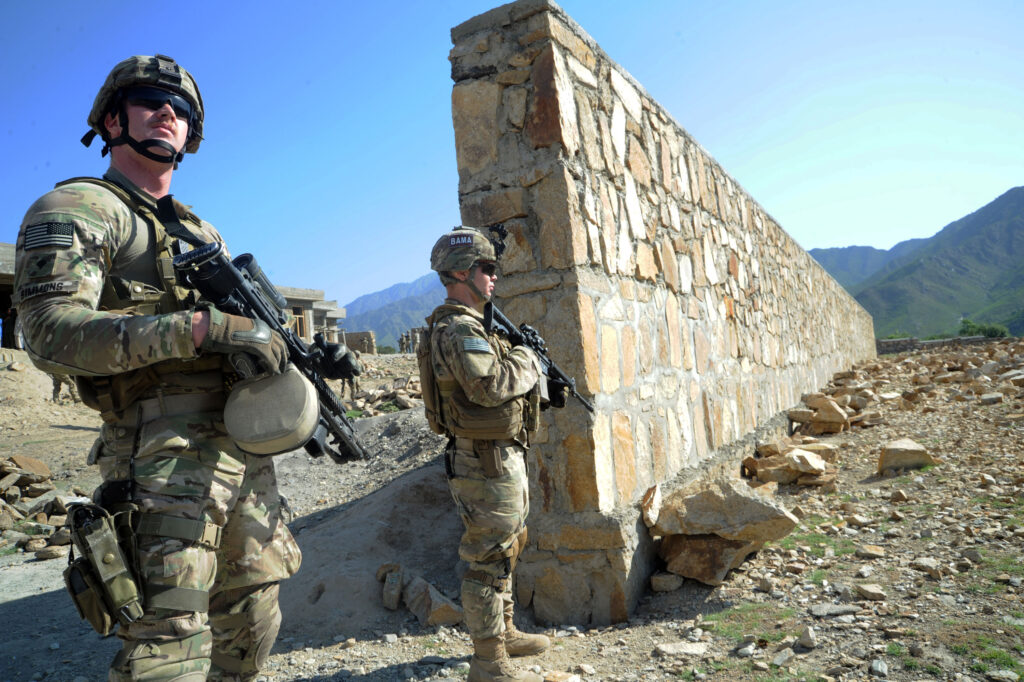
Texas National Guard soldiers in Afghanistan.
WASHINGTON: “Trust, but verify.” On Gus Hargett’s last day at the National Guard Association of the United States, that’s the advice the long-time NGAUS president gave his successor, Roy Robinson, on dealing with regular active-duty leaders.
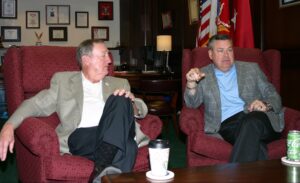
Maj. Gen. Gus Hargett (left), the outgoing president of the National Guard Association of the US, and his successor, Brig. Gen. Roy Robinson.
“I think these guys want to do the right thing,” said Hargett, particularly praising the Army Chief of Staff, Gen. Mark Milley. By contrast, NGAUS was sharply at odds with Milley’s predecessor, Gen. Ray Odierno.
Indeed, Hargett helmed the association during some of the bitterest regular-vs.-Guard battles of the last two decades. “I would hope that we would never get there again,” Hargett told me, citing much-improved relations. “If there’s a collaborative process where we listen to each other and we understand each other, and we are inclusive in the way we talk to teach other, then I don’t know we ever have to get there again.”
But even as Guardsmen make common cause with regulars for bigger military budgets, Hargett and Robinson said, they need a full-time watchdog like NGAUS to make sure whatever money there is gets shared fairly.
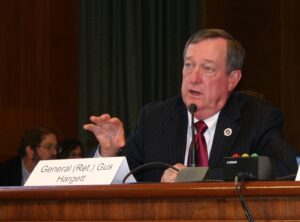
Maj. Gen Gus Hargett
“Sequestration is an issue for all of us, a Continuing Resolution (is) a problem for all of us.” said Roy Robinson, sitting next to Hargett in the NGAUS president’s office this morning. “We intend to be on the front end of trying to help (with that) for all of the services, not just the National Guard.”
“We want to be in that fight,” Robinson continued. “We want to help the Army, we want to help the Air Force equip. We just want to make sure that in the end that the Army and the Air Force are fair about the distribution.”
“We still have a history of putting older equipment into Guard units,” he said. “We still have some challenges on forcing the services to equip in a way that we feel reaches parity. We’re just not there.”
But separate and unequal equipping doesn’t make sense in post-9/11 world where regulars and Guard alike deploy into harm’s way, he argued. In his 33 years in uniform, said Robinson, who retired last year as a one-star general, “the Guard…has changed dramatically, in a way that I don’t think most people could’ve ever conceived. They’re absolutely a part of the total force now.” That means, he said, “just like every other member of the Army and the Air Force, they have to have the best available equipment that money can buy. They have to have an opportunity to train with it, and be prepared with that equipment when the time comes for them to deploy.”
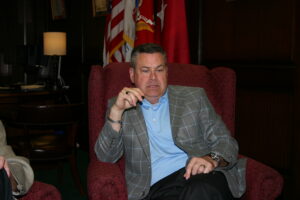
Brig. Gen. Roy Robinson
“That’s where NGAUS comes in. That’s what we do: We make sure that our servicemembers have what they need,” Robinson said. “Without the encouragement of an organization like NGAUS… I don’t believe you would see the eagerness of the part of the service (leadership) to make sure that that equipment parity existed.”
“There should be parity,” he said. “If we can ever get leadership to buy into the importance of that, I actually think that organizations like NGAUS could really help the Air Force and the Army on some of their new equipment issues.”
Modernization is a personal crusade for Robinson, who commanded a Mississippi Guard battalion in Iraq’s Anbar Province in 2005 and lost three soldiers in inadequately armored vehicles. “That’s why I’m so adamant about, no, you don’t ‘go to war with the Army you have;‘ you make sure you have the right army to go to war,” he said.
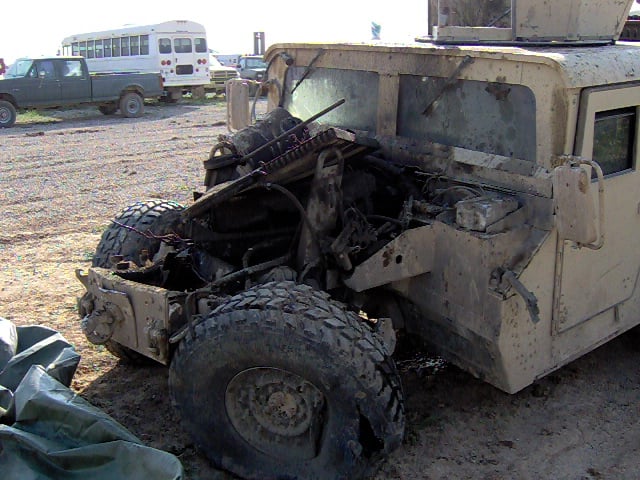
A Humvee destroyed in Iraq in 2005.
The first to die in Robinson’s battalion was Sergeant First Class Sean Cooley, killed by a roadside bomb strike on his Humvee. The other two, Specialist Terrance Lee and Sgt. Larry Arnold, were killed in an M113. That’s a 1960s-vintage tracked transport that, while better than an unarmored Humvee, was still so vulnerable to mine blasts from below that Robinson’s soldiers, like their predecessors in Vietnam, ultimately decided they were safer riding on the roof than inside.
Today, the Army is starting to replace many of its Humvees with Joint Light Tactical Vehicles (JLTV) and M113s with Armored Multi-Purpose Vehicles (AMPV). The regular Army and the National Guard have a strong common interest in getting those programs funded. That said, Robinson emphasized, NGAUS can’t blindly follow the Army line and assume the Guard will get an adequate share of the new vehicles. “In a perfect world that would be great if we could agree that, yes, it’s all a funding issue, but my history tells me that’s not the case,” he said.
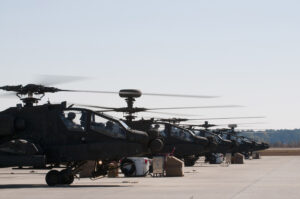
Army National Guard AH-64 Apaches.
The most explosive issue of recent years focused on AH-64 Apache helicopter gunships. Under budget pressure, Army leaders came up with an Aviation Restructure Initiative (ARI) designed to strip the Guard of all its Apaches and transfer them to regular Army squadrons (replacing aging OH-58 Kiowas). NGAUS led the Guard revolt and convinced Congress to refer the Apaches and a host of other issues to a National Commission on the Future of the Army, which ultimately ruled the Guard should keep some gunships.
The Army commission and its forerunner, a similar commission to settle disputes between the Air Force and Air National Guard, were two of biggest events during Hargett’s leadership of NGAUS, he told me. The third? Getting the director of the National Guard Bureau on the Joint Chiefs of Staff. But all these successes require follow-up, Robinson and Hargett argued, to make sure they are implemented as Congress intended.
And new issues can always arise. While the Apache gunship’s fate seems settled, NGAUS is watching the Army’s efforts to upgrade the Black Hawk utility helicopter. The Guard still has many 1980s-vintage UH-60A models, while the latest active-duty model is the UH-60M, with new electronics, a more powerful engine, and other upgrades. Recently, the Army conducted its first flight of the UH-60V, which has the same modernized electronics as the M but none of the other improvements.
Now NGAUS fears the “Victor” will become the lower-cost, lower-capability solution issued to the Guard. “If we pure-fleet the guard with Victors and pure-fleet the Army with M models, that will be the biggest mistake that the Army makes,” Hargett said. “It will be divisive.”
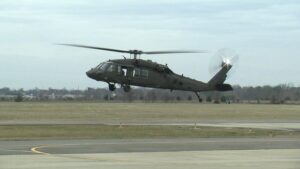
First flight of the upgraded UH-60V Black Hawk.
“It doesn’t matter if you’re talking about C-130s, if you’re talking Apaches, if you’re talking Black Hawks, if you’re talking M1 (tanks),” Robinson said. “If we’re truly going to be prepared to train and fight together… the equipment needs to be the same.”
With all these issues old and new to keep an eye on, he said, “I think NGAUS is…as important as it’s ever been in our history.”
Subscribe to our newsletter
Promotions, new products and sales. Directly to your inbox.
